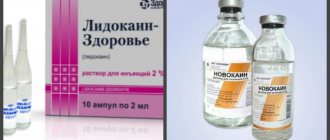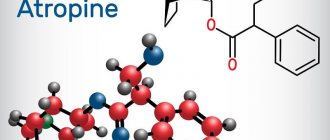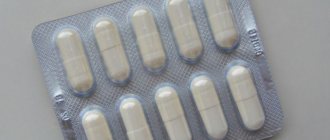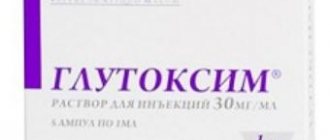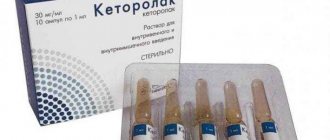pharmachologic effect
Local anesthetic with moderate anesthetic activity and a wide range of therapeutic effects. Being a weak base, it blocks sodium channels, preventing the generation of impulses at the endings of sensory nerves and the conduction of impulses along nerve fibers. Changes the action potential in the membranes of nerve cells without a pronounced effect on the resting potential. Suppresses the conduction of not only pain, but also impulses of other modalities.
When absorbed and directly vascularly introduced into the bloodstream, it reduces the excitability of peripheral cholinergic systems, reduces the formation and release of acetylcholine from preganglionic endings (has some ganglion-blocking effect), eliminates spasm of smooth muscles, reduces the excitability of the myocardium and motor zones of the cerebral cortex.
Eliminates descending inhibitory influences of the reticular formation of the brain stem. Inhibits polysynaptic reflexes. In large doses, it can cause convulsions. It has a short anesthetic activity (the duration of infiltration anesthesia is 0.5-1 hour).
Ceftriaxone: how to dilute Novocaine for adults
As a rule, 1 g (1000 mg) of Ceftriaxone is administered to adult patients at a time, so to dilute it you need to take 5 ml of a 0.5% Novocaine solution. The entire antibiotic solution should be injected into the buttock once a day, the interval before the next injection is 24 hours.
If 2 g is prescribed, then two bottles are diluted separately and 2 injections of 1 g are given, they are often given twice a day, that is, with an interval of 12 hours. It is important to strictly adhere to the administration time to maintain the desired level of antibiotic in the blood.
The exception is the treatment regimen for uncomplicated gonorrhea. The doctor may prescribe just 1 injection of 250 mg, then you need:
- Add 10 ml of 0.5% Novocaine into a bottle with 1 g of antibiotic.
- Dissolve the powder until the liquid is completely transparent.
- Take 2.5 ml of the resulting solution and inject.
Watch this video on how to dilute Ceftriaxone with Novocaine:
Instructions on how to dilute for injections for children
Ceftriaxone for injections for children is diluted with Novocaine in the same way as for adults, that is, for 1000 mg of antibiotic you will need 5 ml of 0.5% painkiller. Then the required dose for administration is calculated - 20-50 mg per 1 kg of body weight and the required volume of the finished solution is collected.
Pharmacokinetics
Subject to complete systemic absorption. The extent of absorption depends on the site and route of administration (especially vascularity and blood flow velocity in the area of administration) and the final dose (amount and concentration). It is rapidly hydrolyzed by plasma and liver esterases to form two main pharmacologically active metabolites: diethylaminoethanol (has a moderate vasodilator effect) and para-aminobenzoic acid (is a competitive antagonist of sulfonamide chemotherapeutic drugs and can weaken their antimicrobial effect). The half-life is 30-50 seconds, in the neonatal period - 54-114 seconds. It is excreted primarily by the kidneys in the form of metabolites; no more than 2% is excreted unchanged.
General rules for diluting Ceftriaxone injections with Novocaine
When diluting Ceftriaxone with Novocaine, it is important to follow the injection rules:
- all manipulations are carried out under sterile conditions;
- hands are washed thoroughly with antibacterial soap (apply and rinse at least three times), dry with a towel;
- you need to use sterile gloves; if they are not available, wipe your fingers with alcohol and then you should not touch any objects except the syringe and ampoules;
- be sure to check the labels on the bottle of Ceftriaxone and on the ampoule of the solvent, compare the batch and expiration date with the packaging;
- After dissolving the antibiotic with Novocaine, it is recommended to change the needle before the injection.
It is better to dilute Ceftriaxone with Novocaine immediately before injection and take no more than 1000 mg of powder and 5 ml of solvent at a time.
How to dilute Novocain
Novocaine for injection is taken only 0.5%, and animals use a 0.25% solution. In pharmacies, the first drug is most often sold in ampoules, and the second is presented in bottles of 200 and 400 ml. There is also a release form with a higher content of active substance - 2%, 2 ml. If for some reason it was not possible to buy a 0.5% solution, then it is allowed to dilute a 2% solution, then for one injection you need to take 1 ml of 2% Novocaine and 4 ml of water for injection.
Requirements for intramuscular administration
Novocaine can be used exclusively for intramuscular administration, and for intravenous injections or droppers, saline solution, water or 5% glucose are used. Basic requirements for injections into the muscle:
- select the upper outer quadrant (the buttock is visually divided horizontally into the upper and lower halves, then the same right and left parts vertically);
- there should be no lumps or pain at the injection site;
- the syringe is inserted at a right angle (perpendicular), and the needle is immersed 3/4 of the entire length;
- In order to avoid pain, swelling and hardening, you need to release the antibiotic solution into the muscle very slowly.
Intramuscular injection technique
Contraindications
Hypersensitivity (including to para-aminobenzoic acid and other local anesthetic esters), children under 12 years of age. Pronounced fibrous changes in tissues (for anesthesia using the creeping infiltration method).
For epidural anesthesia: atrioventricular block, marked decrease in blood pressure, shock, infection of the lumbar puncture site, septicemia.
Carefully
Emergency operations accompanied by acute blood loss; conditions accompanied by a decrease in hepatic blood flow (for example, with chronic heart failure, liver diseases); progression of cardiovascular failure (usually due to the development of heart block and shock); inflammatory diseases or infection of the injection site; pseudocholinesterase deficiency; renal failure; children's age (from 12 to 18 years) and in elderly patients (over 65 years); weakened patients; pregnancy, childbirth, breastfeeding.
Use during pregnancy and breastfeeding
Use during pregnancy and breastfeeding is possible in cases where the expected benefit to the mother outweighs the potential risk to the fetus or child.
Modern analogues of novocaine in dentistry -
Despite the continued widespread use of lidocaine in medical practice, dentistry has long moved away from this anesthetic (24stoma.ru). As we said above, the most effective anesthetics in dentistry at the moment are drugs based on articaine, for example, ultracaine, ubistezin, septanest, alfacaine, etc. These drugs are no longer produced in ampoules (like novocaine or lidocaine), but in special capsules , containing 1.7 ml of anesthetic.
The anesthetic capsule is already ready for use; it does not need to be opened. It is completely inserted into a special carpule syringe, and a special double-sided needle is screwed into the side of the syringe nose (Fig. 1-3). When you press the syringe plunger, the latter presses on a movable rubber tab located in the back of the carpule, which causes an increase in pressure inside the carpule and the release of the anesthetic solution through the needle into the tissue.
How is anesthesia performed in dentistry?
Read more about modern anesthesia in dentistry in the article: → “Everything a patient needs to know about dental anesthesia”
special instructions
Patients require monitoring of the functions of the cardiovascular, respiratory and central nervous systems. Monoamine oxidase inhibitors should be discontinued 10 days before local anesthetic administration.
Before use, it is recommended to carry out tests to determine individual sensitivity to the drug. It must be taken into account that when performing local anesthesia using the same total dose, the toxicity of procaine is higher, the more concentrated the solution is used.
Impact on the ability to drive vehicles and operate machinery
During the treatment period, it is necessary to refrain from driving vehicles and engaging in potentially hazardous activities that require increased concentration and speed of psychomotor reactions.
Directions for use and doses
For infiltration anesthesia, 0.25 - 0.5% solutions are used; anesthesia according to the method of A.V. Vishnevsky (tight creeping infiltration) - 0.125 - 0.25% solutions. For local anesthesia, to reduce absorption and increase the duration of action, add a 0.1% solution of adrenaline hydrochloride to the novocaine solution at the rate of 1 drop per 2 - 5 - 10 ml of novocaine solution. With perinephric blockade according to the method of A.V. Vishnevsky, 50 - 80 ml of a 0.5% solution or 100 - 150 ml of a 0.25% solution of novocaine are injected into the perinephric tissue. To carry out circulatory and paravertebral blockades for eczema, neurodermatitis, sciatica, a 0.25 - 0.5% solution of novocaine is administered. Intravenously administered from 1 peripheral vessels and improve microcirculation during frostbite, a mixture consisting of up to 10 - 15 ml of 0.25 - 0.5% solution is used; administered slowly, preferably in an isotonic sodium chloride solution. The number of injections (sometimes up to 10 - 20) depends on the severity of the disease. Higher doses: for intramuscular administration 0.1 g (5 ml of 2% solution), (20 ml of 0.5% solution); for intravenous administration - 0.05 g (20 ml of 0.25% solution). For infiltration anesthesia, the following highest doses are established: the first single dose at the beginning of the operation is no more than 1.25 g when using a 0.25% solution (500 ml) and 0.75 g when using a 0.5% solution (150 ml). Subsequently, during each hour of surgery - no more than 2.5 g when using a 0.25% solution (1000 ml) and 2 g when using a 0.5% solution (400 ml). To relieve spasms from 10 ml of a 0.25% solution of novocaine, 2 ml of a 2% solution of papaverine, 2 ml of a 1% solution of nicotinic acid and 10,000 units of heparin. It is administered intra-arterially slowly.
Release form and composition
Dosage forms of Novocaine:
- Injection solution 0.5%: colorless, transparent liquid (2, 5 or 10 ml per ampoule; 10 ampoules in a cardboard box, complete with a scarifier or ampoule knife);
- Injection solution 2%: colorless, transparent or slightly colored liquid (2 or 5 ml per ampoule, 10 ampoules in a cardboard box, complete with a scarifier or ampoule knife; 5 ampoules in a strip pack, 2 packs in a cardboard box, complete with a scarifier or an ampoule knife. Packs with ampoules with a ring or a break point do not include a scarifier or an ampoule knife);
- Solution for injection 0.25% (1, 2, 5 or 10 ml per ampoule, 10 ampoules in a cardboard box);
- Solution for injection 1% (1, 2 or 5 ml in an ampoule, 10 ampoules in a cardboard box);
- Rectal suppositories (5 pcs each in a contour package, 2 packages in a cardboard box; 5 pcs each in a contour-free packaging, 2 packages in a cardboard box).
Active ingredient: procaine hydrochloride (in 1 ml of solution - 2.5, 5, 10 or 20 mg; in 1 suppository - 100 mg).
Additional components:
- Solution for injection: water for injection, hydrochloric acid;
- Rectal suppositories: solid fat.
Side effect
Headache, dizziness, drowsiness, weakness, increase or decrease in blood pressure, collapse, peripheral vasodilation, bradycardia, arrhythmia, chest pain, trismus, tremor, visual and hearing impairment, nystagmus, persistent anesthesia, hypothermia, methemoglobinemia, allergic reactions ( up to anaphylactic shock).
Overdose
Symptoms: pallor of the skin and mucous membranes, dizziness, nausea, vomiting, “cold” sweat, increased breathing, tachycardia, decreased blood pressure, even collapse, apnea, methemoglobinemia. The effect on the central nervous system is manifested by a feeling of fear, hallucinations, convulsions, and motor agitation.
Treatment: maintaining adequate pulmonary ventilation, detoxification and symptomatic therapy.
Interaction with other drugs
Strengthens the inhibitory effect on the central nervous system of general anesthesia, sleeping pills and sedatives, narcotic analgesics and tranquilizers.
Anticoagulants (ardeparin sodium, dalteparin sodium, danaparoid sodium, enoxaparin sodium, heparin sodium, warfarin) increase the risk of bleeding.
When treating the injection site of a local anesthetic with disinfectant solutions containing heavy metals, the risk of developing a local reaction in the form of pain and swelling increases.
When using local anesthetic drugs for epidural anesthesia with guanadrel, guanethidine, mecamylamine, trimethaphan camsylate, the risk of developing a sharp decrease in blood pressure and bradycardia increases.
Use with monoamine oxidase inhibitors (furazolidone, procarbazine, selegiline) increases the risk of developing a pronounced decrease in blood pressure.
Strengthens and prolongs the effect of muscle relaxants.
When procaine is prescribed together with narcotic analgesics, an additive effect is noted, which is used during epidural anesthesia, and respiratory depression increases.
Vasoconstrictors (epinephrine, methoxamine, phenylephrine) prolong the local anesthetic effect.
Procaine reduces the antimyasthenic effect of drugs, especially when used in high doses, which requires additional correction of the treatment of myasthenia gravis.
Cholinesterase inhibitors (antimyasthenic drugs, cyclophosphamide, demecaria bromide, ecothiopathy iodide, thiotepa) reduce the metabolism of procaine.
The procaine metabolite (para-aminobenzoic acid) is a sulfonamide antagonist.


